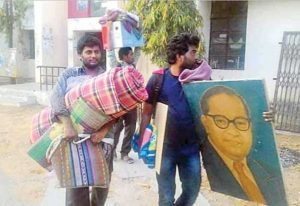The name ‘Rhea Chakraborty’ has become in recent times, a shorthand term to basically refer to a woman who poisons a man’s mind against his family and tricks him into giving her all his money. Without going into the details of the case of Sushant Singh Rajput’s suicide and the subsequent FIR against Rhea Chakraborty, the fact is that no verdict has been made yet and it is without any substantial evidence that this name has been dominating the news cycle through conspiracy theories and gossip articles about her character, for weeks on end.
A moment that could have begun a national conversation on mental health and structural forms of exclusion has been milked for almost a month now for cheap headlines. Hundreds of news articles on the most minor and irrelevant details of the whereabouts, social media posts, so on, of every single person to have ever been associated with Sushant Singh Rajput, are posted every day. This is during one of the biggest crises of human rights, social justice, healthcare, education, and economic welfare in the country.
Structural Issues Not As Lucrative as Individual Villains
What became clear during much of the media coverage of Sushant Singh Rajput’s suicide is that mainstream media in India can’t fathom structural issues without finding villains who become exceptions to the system.
Protest against @karanjohar & @BeingSalmanKhan in Bihar, #JusticeForSushantSinghRajput @shekharkapur @sandeep_author @AsYouNotWish @vivekagnihotri @barkhatrehan16 @Payal_Rohatgi @KillBillBride @akshayerathi @Rajput_Ramesh @Sanju_Verma_ @editorbharathi @Against_Pseudos ?? pic.twitter.com/PYphNHHFeZ
— Neetu ❤ (@NeetalSengar) June 20, 2020
An important conversation on institutional exclusion and mental health stood no chance in front of a woman who could have single handedly induced mental health issues in her live-in partner’s mind in order to control and manipulate him and his wealth.
A possible conversation on upper-caste monopoly of the media and especially Bollywood, was foregone for the much more lucrative option of finding individual flag bearers of ‘nepotism’. As if they had an agenda only against Rajput and were not running a highly brahminical industry that manufactures problematic cultural products and is impossible to break into without caste connections, thus excluding millions of people.
An important conversation on institutional exclusion and mental health stood no chance in front of a woman who could have single handedly induced mental health issues in her live-in partner’s mind in order to control and manipulate him and his wealth. At this point, all hope for the potential for such a conversation should be given up, as mobs of supporters under banners of “Justice for SSR” or “SSR Warriors’ hound Rhea Chakraborty, not only making extremely misogynistic comments about her, but also issuing rape and death threats.
All Suicides Are Not Equal
Rohith Vemula committed suicide, caste-Hindu society was more preoccupied with finding his caste certificate than asking for any form of accountability from his university. There were no mass hate campaigns by caste-Hindu society against P. Appa Rao or Bandaru Dattatreya.
The narrative is this- Sushant Singh Rajput comes from a ‘humble’, ‘middle class’ family and has not only been excluded by the elites of Bollywood but has also been manipulated by Rhea Chakraborty, who is an ‘empowered’ woman with more ‘elite’ connections. While it may be true that Sushant Singh Rajput was an ‘outsider’ by Bollywood’s standards, the truth is, this mob of ‘warriors’ is not interested in the power dynamics of bullying and exclusion.


The romanticisation of an upper-caste Bihari man’s humble beginnings and the support it has gathered is in stark contrast to the suicides that should have shaken this country’s conscience a long time ago. Just four years ago, after Rohith Vemula committed suicide, caste-Hindu society was more preoccupied with finding his caste certificate than asking for any form of accountability from his university. There were no mass hate campaigns by caste-Hindu society against P. Appa Rao or Bandaru Dattatreya. Just a year ago, after Payal Tadvi committed suicide, there were no calls for justice from caste-Hindu society against Bhakti Mehare, Ankita Khandelwal or Hema Ahuja. And in these cases, there was actual proof of their consistent bullying and harassment, as well as its perpetrators.
Lack of Regard for Journalistic Ethics
News reports have publicly announced Rhea’s address, her phone number, have tracked her every day whereabouts, leaked her call and message records, and made conspiracy theories without any proof.
Sushant Singh Rajput’s parents are well within their right to file an FIR regarding whatever accusations they have, even though some of them could be seen as questionable, including a complaint about why their consent was not sought before he went into mental health treatment. The due course of justice should investigate and address their accusations in a fair manner.
But the treatment of this case by the media goes against all ethics of journalism. News reports have publicly announced Rhea’s address, her phone number, have tracked her every day whereabouts, leaked her call and message records, and made conspiracy theories without any proof. A Mumbai resident who had a number similar to Rhea Chakraborty’s number has received abusive phone calls and threats for three days, distressing even him. What effect would this have on a woman who has received this abuse for weeks on end, where there is a chance for such threats to translate to physical violence?
Bengali Stereotyping and Pride
A strain of hate against Rhea Chakraborty has also focused on her Bengali identity, referring to Bengali women as ‘witches’ who ‘trap’ men. In response to this, many have started defending Bengali cultural identity, be it while supporting or opposing Rhea Chakraborty. It is important to note that Bengali identity is not one that is particularly disadvantaged in the larger scheme of Indian politics or media, even though a section of upper-caste Bengalis try very hard to set themselves intellectually and culturally apart as superior to the ‘cow-belt’.
The large-scale migration of Bahujans from Bihar to Bengal, and especially Calcutta, who are largely employed as manual and contractual labour, has given rise to common anti-Bihari rhetoric in West Bengal about “outsiders” who are uncultured and dirty. In fact, a viral video for which Rhea herself has been attacked by Sushant Singh Rajput’s supporters is of her performing a long joke ridiculing a lower class woman. Hence it is misleading to take this opportunity to assert Bengali caste pride with respect to the supposed women’s empowerment, liberal values, and sexual freedom in Bengal.
However, there is no doubt that no matter what the women’s identities in this case had been, they would all have been attacked in the common patriarchal tactic of seeing a woman as being owned by her family and community.
Untrustworthy Women and Fake Feminism
The ‘warriors’ in support of Sushant Singh Rajput have coincided with two other (often, incestuous) groups- ‘mens’ rights activists’ on one hand and the right wing on the other, along with its trolls and media spokespersons. For men’s rights activists, this case is simply evidence for a long standing argument about male suicides being caused by the rise of ‘fake feminism’, and the supposed manipulation of men by women. The reason why this particular case, often with very irrelevant updates, has been so widely circulated and refused to leave the news cycle is that it confirms existing misogynistic ideas about women’s supposed ‘power’ over men.
By virtue of their sex, women have historically been seen as untrustworthy and sexually manipulative, a view endorsed by Hindu scriptures and various cultural products. In contrast, men are seen to be simple, righteous, and easy to manipulate. This serves to justify the inequality of actual, material power between men and women, as well as to legitimise the punishment of women for their inherently inferior personalities. This narrative of a woman capitalising off of her partner’s wealth and tearing him apart from his family often becomes the context for financial and physical abuse, and ostracisation, by in-laws against married women.
Right Wing Interest
It was not long ago that Kangana Ranaut, before she was crying for justice for Kashmiri Pandits and cows, was also followed by a campaign to label her as a manipulative, crazy, witch. She is now, however, a champion of anti-nepotism with a large right-wing following, as she blames Deepika Padukone for having orchestrated JNU protests and boycotting Sushant Singh Rajput, all in one breath. Similarly, Arnab Goswami has taken a special interest in conducting this media trial, and trolling accounts abusing Rhea Chakraborty often also carry saffron in their bios. The right wing’s investment in this case is interesting, as the spotlight, just a few weeks ago, was on Bollywood personalities well known to attend private meetings with the Prime Minister and working on nation-building projects in Bollywood.
Further, the case is also an important marker in gathering support in upcoming elections and the power struggle between the state government in a non-BJP state and the central government. While the ‘warriors for justice’ narrative is that the change in jurisdiction is in order to escape the influence of the Bollywood elite that functions through the Shiv Sena, known to have used a lot of anti-Bihari rhetoric, it is important to remember that the Bihar police as well as the CBI is closer to the influence of the BJP, which is especially interested in reducing mass support for the Shiv Sena. Rajput’s family too, must have recognised the advantage they can get from their powerful caste community which the state government counts on back home.
Why is the Media Doing This?
That the mainstream media is covering this case to this degree and creating such a captive audience is important in terms of the distraction it has created from several major erosions of social justice in the country during this period. These include but are not limited to large scale unemployment, lack of accessible healthcare during a pandemic, dilution of labour rights, large-scale privatisation of public sector undertakings, anti-farmer laws, unlawful arrests of anti-caste activists and interrogations of dissenting voices, arrests of protestors, medical negligence in prisons, auctioning off of natural resources, inaccessible online education, and so on. As long as people obsessively consume the latest updates regarding who said what in this case, they will not know that the government is completely failing to take care of its citizens during this critical and distressing period. In this context, the decision to constantly report on a case which is yet to go to court, is nothing but an insidious distraction masquerading as a quest for ‘justice’.




























[…] Sushant Singh Case and Rhea Chakraborty: A Distraction From Government’s Failure […]